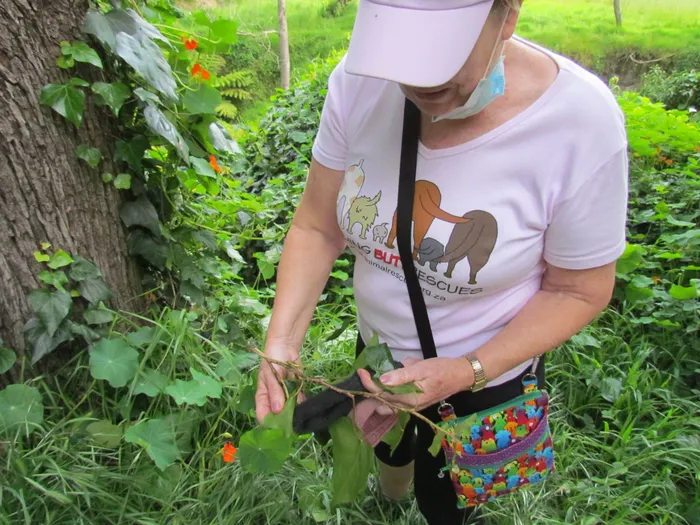Ivy smothering greenbelts

Sue van der Walt with English ivy, a reservoir for a harmful plant pathogen which affects ornamental trees such as oaks, maples and elms that also occur in the Constantia area.
When Sue van der Walt moved to Constantia earlier this year, she would take her dog, Tina, for a walk on the Alphen Trail twice a day, and she soon noticed how ivy was spreading and smothering trees and anything else in its path.
Driving around the area, Ms Van der Walt was distressed to see other areas infested with ivy - Constantia Main Road, High Constantia, Brommersvlei Road - and trees dying at a rapid rate.
She tried to rescue trees by pulling the ivy tendrils off their trunks. People stopped to ask her what she was doing. They then noticed the ivy infestation and what it is doing to the greenbelt. She says they are horrified at what they see and promise to go home, clear their gardens of ivy and speak to their neighbours.
“We cannot delay the efforts to rid Constantia and surrounding greenbelts and pavements of the invasive ivy,” says Ms Van der Walt. She contacted the Constantia Residents’ and Ratepayers’ Association (CRRA) and asked them to do something.
Dr Clive McDowell, who heads up the CRRA’s green environment portfolio, says both the canary ivy (Hedera canariensis) and English ivy (Hedera helix) are wreaking havoc in our woodlands. “Not only do they ‘smother’ trees with their exuberant growth, they create ‘sail effects’ when mature, causing their hosts to blow over,” he says.
Ivy is dispersed by seed in bird droppings and by ignorant nurseries, under-informed gardeners and landscapers. Dr McDowell says he recently pointed out this pest as a top priority for removal in natural woodland areas, especially in De Hel, “the jewel in the crown of our green belts”.
Ms Van der Walt contacted Fay Howa, the City’s environmental manager with recreation and parks, based at Newlands.
Ms Van Der Walt had heard about a trial controlling the ivy using the hand pulling method being conducted in De Hel Conservation Area in May and June. The effects of the trial are yet to be determined, but it seems that hand pulling is more appropriate for sensitive riparian areas, Ms Howa told her. Once the ivy’s roots have been removed from the ground, the ivy can be placed in a pile as it quickly decomposes.
Mayoral committee member for community service and health Zahid Badroodien says ivy climbs tree trunks using root-like structures that produce a glue-like substance to help it stick to surfaces.
The vines spread out and enclose the tree canopy, essentially blocking the host tree’s access to sunlight for photosynthesis. English ivy, in particular, is a reservoir for a harmful plant pathogen called Xylella fastidiosa which affects ornamental trees such as oaks, maples and elms that also occur in the Constantia area.
Dr Badroodien says these plants grow aggressively and quickly jump from private properties to the neighbouring open spaces. The ivy is able to colonise the surrounding areas by growing along the ground to form carpets that suppresses the growth of other plant species and therefore reduces the biodiversity of the area, he says.
As for control, Dr Badroodien says there is no biological control. And the National Environmental Management Biodiversity Act (NEMBA) has ivy species listed as a Category 3 invader on public open spaces. This means that ivy may not be owned, imported into South Africa, grown, moved, sold, given as a gift or dumped in a waterway. In riparian zones or wetlands, Category 3 species are moved to Category 1b which means these plants are deemed to have such a high invasive potential that infestations require compulsory removal and destruction.
Ms Van der Walt believes clearing of the ivy could be a job-creation project.
Colin Walker, chairman of the Friends of Constantia Valley Greenbelts (FoCVG), asks users to spend a few minutes pulling ivy out at the root. Every little bit helps, he says. He says it is very easy to pull ivy off the trunks, especially from indigenous trees, which usually have a smoother bark.
“If you can’t pull all the ivy off, sever the stem/shoots at the bottom of the tree and pull it away from the trunk. The Ivy stem left adhering to the tree will die and eventually fall off,” says Mr Walker.
If a group wants to adopt a trail, or a patch, or do a hack, they can contact FoCVGB through their Facebook page and someone will put them in contact with the appropriate river warden for the greenbelt in which they want to work.


